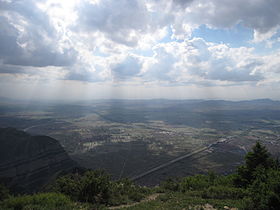- Mount Heng (Shanxi)
-
Heng Shan 
View from the summit of Heng ShanElevation 2,017 m (6,617 ft) Location Location Shanxi, China Coordinates 39°40′26″N 113°44′08″E / 39.67389°N 113.73556°ECoordinates: 39°40′26″N 113°44′08″E / 39.67389°N 113.73556°E  The "Hanging Monastery" at Heng Shan, Shanxi
The "Hanging Monastery" at Heng Shan, Shanxi
Heng Shan or Heng Mountain (simplified Chinese: 恒山; traditional Chinese: 恆山; pinyin: Héng Shān) in Shanxi Province is one of the Five Sacred Mountains of Taoism. At 2,017 m, it is one of the five tallest peaks in China Proper. Heng Shan in Shanxi Province is sometimes known as the Northern Heng Shan, and the one in Hunan Province as Southern Heng Shan (Chinese: 衡山; pinyin: Héng Shān). Both mountains have the same pronunciation in Chinese, and the Southern Heng Shan is also one of the Five Sacred Mountains.
Contents
History
Like the other four sacred Daoist mountains in China, Heng Shan has been considered a sacred mountain since the Zhou Dynasty. Due to its northerly location, the mountain has made it impossible for pilgrimages by the Chinese to take place for much of its history. Because of this, Hengshan is not nearly as religiously important in China as the other four Daoist mountains.[1]
Temples
During the Han Dynasty, a temple called the Shrine of the Northern Peak (Beiyue Miao), dedicated to the mountain god was built on Hengshan's slopes. While periodically destroyed and rebuilt, this temple has an uninterrupted history from Han times to the present day.[1] During times of occupation by non-Han Chinese people, worship to Hengshan was done at the Beiyue Temple in Quyang.
The most famous temple at Hengshan is not Daoist, but is actually the Buddhist Hanging Monastery (Xuankong Si).[1] The Hanging Monastery stands at the foot of Mt. Hengshan and is one of the most dramatic sights at Hengshan - a wooden temple clinging to the cliff side, appearing to defy gravity with only a few wooden posts as support. The Hanging Monastery, built in 491, has survived more than 1,400 years. The extant monastery was largely rebuilt and maintained in the Ming Dynasty (1368–1644) and Qing Dynasty (1644–1911). The buildings were restored in 1900 and there are 40 wooden halls and structures linked by an ingenious system of pillars, posts and walkways.
See also
- North Silk Road
References
Notes
Sources
- Goossaert, Vincent. "Hengshan." in Fabrizio Pregadio, ed., The Encyclopedia of Taoism (London: Routledge, 2008), 481-482.
Sacred Mountains of China Five Great Daoist Mountains Four Sacred Buddhist Mountains Shanxi topics Taiyuan (capital) General Geography Cities • Taihang Mountains • Lüliang Mountains • Yellow River • Fen River • Mount Wutai • Mount Hua • Great Wall of China • Xiechi LakeEducation Culture Visitor attractions Categories:- Mountains of China
- National parks of China
- Sacred mountains
- Taoism
- Geography of Shanxi
Wikimedia Foundation. 2010.
